Seoul P.G. Site Div.
- home
About KOMIPO
Branches
Seoul P.G. Site Div.
World’s first large-capacity urban underground power plant, now roars out of the gate with the energy for Seoul.
KOMIPO has achieved the feat of building the world’s first large-capacity urban underground power plant―the result of Korea’s technology and know-how for building and operating thermal power plants―on the site of the first thermal power plant in Dangin-dong, Mapo-gu, a representation of the nation’s power industry. It initiated commercial operation and started producing electricity in November 2019.

56, Tojeong-ro, Mapo-gu, Seoul
Only 0.02% of electricity consumed in Seoul was produced in the city prior to the completion of Seoul P.G. Site Div. Electricity produced at Seoul P.G. Site Div. is 800 MW, about half the amount of the total electricity used by 3.7 million households in Seoul. Seoul P.G. Site Div. supplies not only electricity, but also heating energy, to 100,000 households in adjacent areas, such as Yeouido, by sending steam produced in the process of power generation to the heat supply facilities. This decreases the emission of environmental pollutants and leads to the reduction of CO2 by 78,000 tonnes per year, compared to the individual heating system of households.
In the event that the power grid is cut off due to war or disaster, or where a problem occurs to the electricity supply to the Seoul metropolitan area, the plant ensures the essential power supply to important facilities. In particular, since the power generation facilities are located underground, there is a strong advantage in its security.
-
"Asian Power Awards 2020" Top Gas-fried Power Plant in Asia
-
"2020 Global Energy Awards of S&P Global Platts" Best Architecture Project
A brilliant feat of Korea's 90-year history of power generation
-
"The 20th Korea Safety Award" Presidential Award
-
A clean and safe underground power plant
Using LNG as the fuel source, Seoul P.G. Site Div. does not emit sulfur oxides and dust unlike coal-fired power plants. Seoul P.G. Site Div. operates its power plant to emit under 5 ppm of nitrogen oxide, which is much less than the 20 ppm (O2 15%) emission standard according to the Clean Air Conservation Act. The power plant is equipped with a low NOx burner that reduces the production of nitrogen oxide by lowering the peak flame temperature, as well as the NOx reduction facility, an optimal prevention facility, on the rear, to replace nitrogen oxide generated during the combustion with nitrogen and steam.
A thick wall surrounds the underground power plant to prepare for earthquakes and flooding of the Hangang River. It is much thicker (4.2 m) than the exterior structure of a nuclear power plant (1.2 m), designed to withstand vibration energy of a large earthquake. The power plant is also specially designed and constructed to fundamentally block gas leaks, and permanent monitoring is ongoing for its gas supply and operation to automatically stop if any problem occurs.
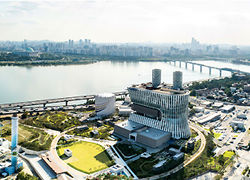
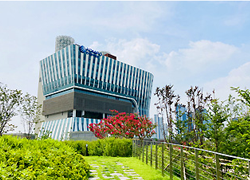
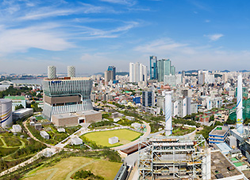
-
Mapo Saebit Culture Forest, a public urban green space for citizens to unwind
As the power plant was constructed underground, the land above turned into an urban regeneration park (Mapo Saebit Culture Forest) that citizens can freely visit anytime. In the past, the power plant site was a security zone that banned the access of outsiders, but in 2020, the park was constructed with the completion of a new power plant, which made the whole area a new landmark with open, scenic landscape by the Hangang River.
-
First thermal power plant in Korea, and a historic scene embracing the 100-year history of electricity
Starting with units 1 and 2 of the Dangin-ri Power Plant, it expanded its facilities to unit 3 in 1950, unit 5 in 1969, and unit 4 in 1971, accounting for 75% of the power supply in Seoul in the 1970s, and it is an industrial heritage that portrays the economic growth of Korea.
Dangin-ri Thermal Power Plant in Seoul reflects the changing history of energy use in Korea, using different fuels from coal to low sulfur oil, and again to LNG, in line with contemporaneous transitions. In addition, it added the facility for heat supply to supply heating energy to the Seoul region.
-
Taking the lead in Seoul for another 100 years of Korea
Seoul P.G. Site Div. has been a solid foundation for the energy industry of Korea, setting milestones for 100 years in the history of Korea’s power generation. Now, Seoul P.G. Site Div. is preparing another 100 years ahead. It has used different fuels according to the transition of the age, applied new technologies in the energy industry, and spread technical skills to power plants throughout the nation. By making an underground thermal power plant, Seoul P.G. Site Div. suggested a new, future-oriented model of power plant in the energy industry, which will mark the beginning of a new history of the power generation industry in Korea.
-
Facility status
Fuel used : LNG / Renewable energy / SRFscroll
Facility status(Combined cycle(LNG), Fuel cell, Photovoltaics, Wind power (Yangyang), Solid refuse fuel (Wonju), Total) Combined cycle(LNG) Fuel cell Photovoltaics Wind power (Yangyang) Solid refuse fuel (Wonju) Total 800MW(400MWx2) 5.6MW 1.3MW 3MW(1.5MWx2 units) 10MW 819.9MW -
Worlds first challenge! Construction of Seoul Combined Power Plant
Built in Seoul in 1930, Korea's first power plant will undergo a significant change. It will soon be home to the world's first underground combined cycle power plant. Meet the five workers at Seoul P.G. Site Division behind the construction of this underground combined cycle power plant. Choi Myeong-gi (Civil Engineering Team) is the face behind the foundation of the construction Construction is fully under way at the underground power plant of Seoul P.G. Site Division. The site goes up to 35 meters deep. The underground use of construction vehicles was possible thanks to the roads built by the Civil Engineering Team. Isn't it difficult working underground? We had to start from scratch. And we had to go down 35 meters underground every day, which was a huge burden on our knees, but we took pride in our role in building the world's first underground power plant. From scratch, our team created the infrastructure necessary to construct a magnificent underground power plant. How large is the scale of the construction? We've excavated 940,000 cubic meters, then created these underground structures with 160,000 cubic meters of concrete. On a rough estimate, we used around 26,000 batches of ready-mixed concrete on this construction site. Thanks to these efforts, we were able to safely create these underground structures. The construction of the underground plant was made possible thanks to the Civil Engineering Team. After the completion of these underground structures behind me, the actual installation of the power plant facilities could begin. Let's hear about the installation of the power facilities from Deputy General Manager Seo Gyeong-won. Seo Gyeong-won (Mechanical Engineering Team) who installs main equipment and heart of the power plant The most important thing in a power plant is the main equipment. Currently, installation of the main equipment is complete, including the installation of the gas turbine. Seo Gyeong-won (Mechanical Engineering Team) is in charge of installing the gas turbine and electrical equipment. We're told that installing a generator in an underground power plant wasn't as easy as it sounds. The hardest task while installing the underground generator was bringing in the main equipment for installation. For power plants above ground, you can easily use cranes and fork lifts. However, it is difficult to use these methods for undergound power plants. We used large cranes and lift devices to bring in and install equipment. As much as this is the world's first underground power plant, we hear they are newly incorporating a special device. The device they are planning on installing is a thermal imaging camera. But what exactly is a thermal imaging camera? This is a thermal imaging camera. These devices are usually used to detect abnormalities in machines by measuring the temperature. Seoul Power Plant also uses these devices when a fire occurs as a firefighting measure to detect fire when there's a lot of smoke. Let's meet another worker partaking in the construction of the underground power plant. Please welcome Mr. Kang Min-seok. Kang Min-seok (Electrical & Control Engineering Team) who facilitates worker convenience I'm Kang Min-seok of Seoul P.G. Site Division's Electrical & Control Engineering Team. Today, we found out exactly why Mr. Kang is always so busy at work. We hear that he's in charge of configuring the main backbone switch of the plant's network system. What is a backbone switch? A backbone switch is a device that collects all circuits of a network in one place, and can be used as a business network. This includes CCTVs, AV device networks, and other telecommunications that ensure worker safety and convenience. Our supervisor also has another person to introduce. A very special space will be created when the construction of the power plant is complete. Let's hear more about this place from General Manager Jeong Hak-gi. Jeong Hak-gi (Architectural Engineering Team), an extraordinary person who will add specialness to this underground power plant. As the world's first large-scale urban underground power plant, Mr. Jeong tells us that he is preparing a very special space in this plant. You have the power plant underground But above the power plant, we plan to create a park where citizens can rest. We designed the park so that residents can fully enjoy themselves and included a resting area and playground for children. They plan to do landscape work on the upper parts of the underground power plant to create a cultural and resting space for citizens. By creating a park above the power plant, we hope to give residents a place they can rest. We also hope that this park can become a bridge between the Hangang River and Hongdae. Not only do we focus on development and coexistence with residents, but we are actively supporting SMEs in various ways Let's go meet Deputy General Manager Lee Poong-woo of the Construction Planning & Management Office who is in charge of these projects! Promoting a synergetic relationship with residents and SMEs is the representative of the Construction Planning & Management Office, Deputy General Manager Lee Poong-woo. Today, Seoul P.G. Site Division is holding a business fair for purchase and consultation. We are hosting this event to promote mutual growth with top-tier domestic corporations. We have around 17 companies attending today. In 2003, we were the first domestic power production company to support SMEs, and have continued such projects ever since then. Last year in 2018, we provided up to KRW 17.7 billion to support technology development products by SMEs. Furthermore, in 2020, we plan to purchase approximately KRW 250 billion worth of technology development products by SMEs. In addition to business fairs, the team seems very busy due to the near-completion of our Seoul underground power plant. After the plant is completed, they expect to generate enough electricity for 2 million households. To find out when the construction for this underground power plant will be complete, Let's meet the overseer of this project, Manager Park Hyeong-geun The project progress rate for the Seoul Combined Cycle Power Plant is at 97%. Tests for both power generation facilities will be complete by August, which will contribute to the stabilization of energy supplies for the latter half of this year. We're trying our best to complete the interior and exterior construction for our integrated office by the end of October, and wrap up all landscape and road construction by the end of December. The Seoul Underground Combined Cycle Power Plant is more than just a power plant to these workers. What does the Seoul Combined Cycle Power Plant mean to you? It's my first love. I've spent my 30s at the plant. It is an essential part of my life. My future. This plant is a new page in history. President Park Hyeong-gyu of Seoul P.G. Site Division, who is a prominent global energy leader devoted to enriching our lives, has also expressed his eagerness to see the completion of the world's first underground power plant. I hope all our workers at Seoul P.G. Site Division complete the project safely and create the world's most premier power plant. To everyone at Seoul P.G. Site Division, let's do our best!
-
Local social contribution activities
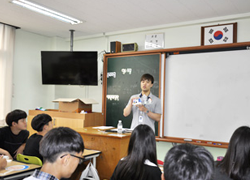
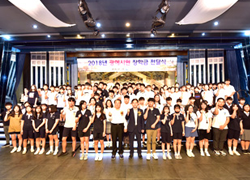
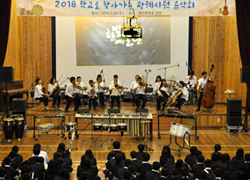
scroll
Local social contribution activities Program, details
Program details Educational materials Support of teaching materials requested by local schools English camp Support to elementary school students participating in English camps Gwanghyesiwon Friends scholarship Middle and high school students recommended by principals of local schools Invited personalities and humanities lectures Special lectures on humanities delivered by personalities at local middle and high schools School-visiting energy education Lectures and training on electricity generation principles
Began as the “10 MW RDF Combined Heat and Power Plant Empirical Project
KOMIPO began the project with participation by the Korea Institute of Energy Research (KIER), Korea Institute of Machinery and Materials (KIMM), and POSCO. Located in Wonju Enterprise City, this 10 MW power plant has been in operation since construction in May 2015.

2, Sinpyeong-ro, Jijeong-myeon, Wonju-si, Gangwon-do
Renewable energy technology development program of MOTIE
Wonju Green Combined Heat and Power Plant uses solid recovered fuel (SRF) as its main fuel as well as refuse-derived fuel (RDF) produced in Wonju. It is actively cooperating with the national policy for the development of alternative energy sources and waste recovery, contributing to the reduction of GHG emissions.
-
Spearheading the national alternative energy source development policy
-
Contributing to the reduction of greenhouse gas emissions
-
Responding actively to the waste recovery policy
-
Facility status
scroll
Facility status of Wonju Green Combined Heat and Power Plant(Boilers, Power generation facilities) Boilers Power generation facilities Fluidized bed (drum-type) steam generation 60 t/h Power output 10MW (+Heat supply 16.6 Gcal/h) -
Wonju Green Combined Heat and Power Plant’s scholarship recipients (2020)
Ministry of Trade, Industry and Energy ? Announcement No. 2017-199 (Dec. 29, 2017) The list of recipients of the 2020 scholarship from Wonju Green Combined Heat and Power Plant are disclosed as follows pursuant to Article 12(7) of the “Guidelines for Implementation of Support Programs for Areas Nearby Power Plants.”
-
Selection of recipients: Subject to official recommendation
-
Wonju: Head of Gangwon Provincial Office of Education Wonju Branch (Director for Education)
-
Hoengseong: Head of Hoengseong-gun Office (Director for Environment and Forestry)
-
-
Payment: Sep. 22-23, 2020
-
Amount
-
Wonju: KRW 500,000/person x 9 persons = KRW 4,500,000
-
Hoengseong: KRW 500,000/person x 1 person = KRW 500,000
-
scroll
Wonju Green Combined Heat and Power Plant’s scholarship recipients (2020) (No., Name, School, Grade, Amount, Payment, Recommending agency and number of recipients) No. Name School Grade Amount Payment Recommending agency and number of recipients 1 PARK ** Taejang Middle School 3 KRW 500,000 Sep. 22-23, 2020 Gangwon Provincial Office of Education Wonju Branch
(9recipients))2 PARK ** Chiak Middle School 1 KRW 500,000 3 JEONG ** Munmak Middle School 3 KRW 500,000 4 SHIN ** Jinkwang Middle School 1 KRW 500,000 5 YOON ** Wonju Daeseong Middle School 3 KRW 500,000 6 YOON ** Seomgang Middle School 3 KRW 500,000 7 SONG ** Wonju Girls’ High School 1 KRW 500,000 8 KIM ** Bukwon Girls’ High School 2 KRW 500,000 9 JANG ** Yukminkwan High School 2 KRW 500,000 10 SHIM ** Chungwon High School 2 KRW 500,000 Hoengseong-gun Office (1 recipient) -